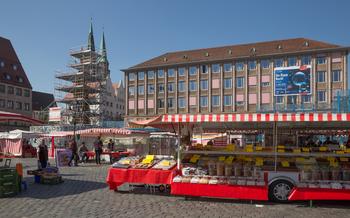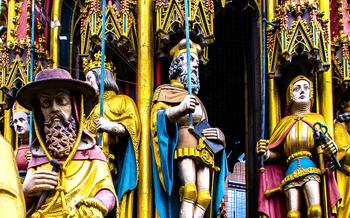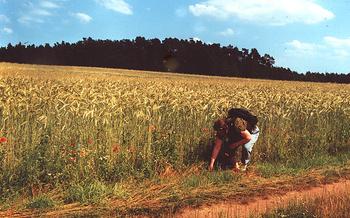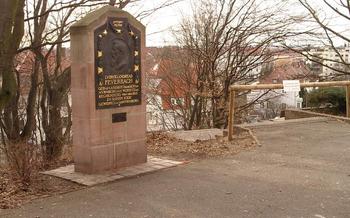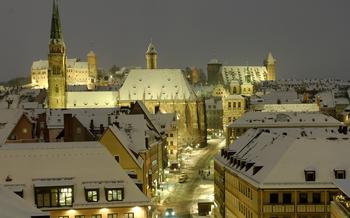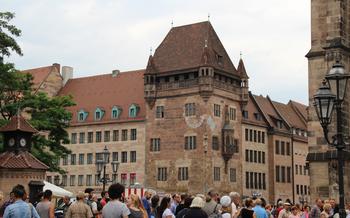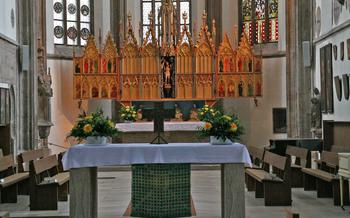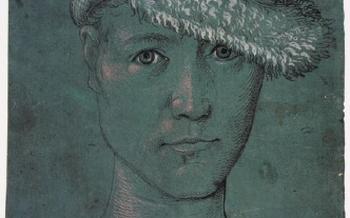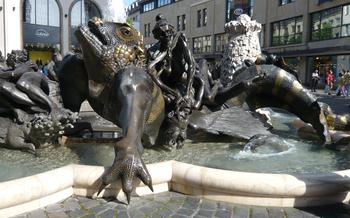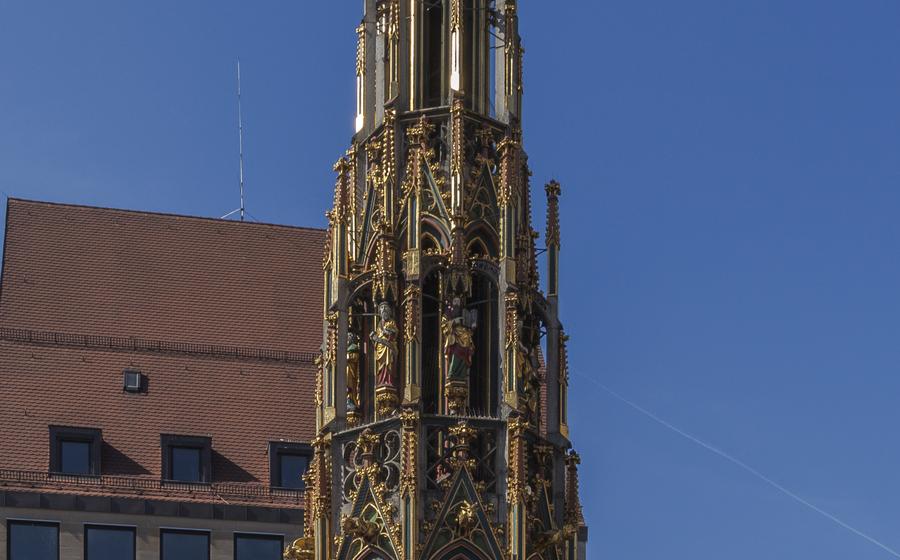
Celler Loch (Medieval Prison)
- Location and Getting There
- Architecture and Design
- Exhibits and Displays
- Guided Tours
- Virtual Reality Experience
- Events and Programs
- Accessibility and Facilities
- Photography and Videography
- Hours of Operation and Admission Fees
- Duration of Visit
- Food and Beverage Options
- Nearby Attractions
- Historical Context
- Insider Tip: Unraveling the Mystery of the Forgotten Torture Chamber
Location and Getting There
The Celler Loch is conveniently situated in the heart of Nuremberg's historic district, at Rathausplatz 2, just a short walk from the iconic Nuremberg Castle and the bustling Hauptmarkt square. Visitors can easily reach the prison by foot from various points in the city center. For those arriving by public transportation, the closest tram stop is "Rathaus," served by lines 4 and Alternatively, the "Lorenzkirche" stop on lines 5 and 7 is also within walking distance. For those driving, there are several public parking garages nearby, such as the "Tiefgarage am Rathaus" and the "Parkhaus am Hallplatz."
The surrounding area is steeped in historical charm, with many notable landmarks and attractions nearby. The majestic Nuremberg Castle, with its imperial halls and panoramic views, is a must-visit for history buffs. The Hauptmarkt, Nuremberg's central square, is renowned for its beautiful fountain, the Schöner Brunnen, and the ornate Frauenkirche church. Visitors can also explore the nearby Albrecht Dürer House, dedicated to the life and works of the renowned Renaissance artist, or take a leisurely stroll along the picturesque Pegnitz River, which meanders through the heart of the city.
Architecture and Design
The Celler Loch is a testament to the architectural ingenuity of the Middle Ages. Constructed primarily of sandstone and half-timbered elements, the prison's exterior blends seamlessly with the surrounding historic buildings. Its imposing facade features a series of arched windows and doorways, hinting at the dark secrets held within.
The interior of the Celler Loch is a labyrinth of narrow corridors, low-ceilinged chambers, and cramped cells. The walls are adorned with faded frescoes and graffiti etched by former inmates, adding to the eerie atmosphere. The cells themselves are tiny and sparsely furnished, with just a wooden plank bed and a chamber pot. The conditions in which prisoners were held were harsh, and the lack of ventilation and light made the Celler Loch a truly oppressive environment.
One of the most chilling features of the Celler Loch is the torture chamber. This grim room contains a variety of instruments of torture, including a rack, a thumbscrew, and a branding iron. The sight of these devices is a sobering reminder of the brutality of medieval justice.
Over the centuries, the Celler Loch has undergone several renovations and restorations. However, great care has been taken to preserve the original structure and authenticity of the prison. Today, the Celler Loch stands as a remarkably well-preserved example of medieval architecture, offering visitors a unique glimpse into the harsh realities of life in a medieval prison.
Exhibits and Displays
The Celler Loch houses a variety of exhibits and displays that bring the harsh realities of prison life and the legal practices of medieval Nuremberg to life. Visitors can explore the dimly lit cells, where prisoners were often confined in cramped and unsanitary conditions. The torture chamber, with its chilling collection of medieval instruments, provides a glimpse into the brutal methods used to extract confessions from accused criminals. In the execution room, visitors can learn about the various methods of capital punishment employed in Nuremberg during the Middle Ages.
Artifacts, documents, and interactive elements further enhance the visitor experience. Ancient scrolls and manuscripts shed light on the legal processes and punishments of the time. Interactive displays allow visitors to virtually experience the sights and sounds of medieval Nuremberg, immersing them in the city's rich historical tapestry. These exhibits collectively contribute to a comprehensive understanding of the Celler Loch's significance and the broader history of Nuremberg's medieval justice system.
Guided Tours
Enhancing the visitor experience at the Celler Loch are guided tours that provide a wealth of insights and historical context. These tours are conducted by knowledgeable guides who bring the prison's past to life, sharing stories of the prisoners who once languished within its walls. Visitors can choose from a variety of tour options, including general tours that cover the history and architecture of the prison, as well as more specialized tours that focus on specific aspects of its operation, such as the torture chamber or the execution room.
Guided tours are offered in several languages, ensuring that international visitors can also benefit from the experience. The frequency of tours varies depending on the season and demand, but they are typically offered several times a day. It is advisable to book tours in advance, especially during peak tourist seasons, to avoid disappointment. Booking online or through the Celler Loch website is recommended for convenience and to secure a spot on the desired tour time.
The guides not only provide historical information but also point out significant architectural features and hidden details that visitors might miss if exploring on their own. They can answer questions, offer insights into the lives of the prisoners, and share anecdotes that bring the Celler Loch's history to life. Guided tours are highly recommended for those who want to gain a deeper understanding of the prison and its role in Nuremberg's medieval justice system.
Virtual Reality Experience
Immerse yourself in the chilling world of medieval justice with the Celler Loch's cutting-edge virtual reality (VR) experience. Don a VR headset and step back in time to witness the harsh realities of prison life in the 14th century. Explore the dimly lit cells, interact with virtual characters, and experience firsthand the trials and tribulations of those incarcerated within these ancient walls. Through the power of VR, you'll gain a deeper understanding of the legal practices, social norms, and human suffering that shaped Nuremberg's medieval past. Don't miss this unique opportunity to delve into history in a truly immersive and interactive way.
Events and Programs
The Celler Loch is not just a historical landmark; it also serves as a vibrant cultural venue hosting various events, workshops, and educational programs throughout the year.
-
Medieval Demonstrations: Experience history come alive with interactive demonstrations of medieval crafts, weaponry, and daily life. Watch skilled artisans showcase their talents in blacksmithing, leatherworking, and other traditional practices.
-
Historical Workshops: Participate in hands-on workshops that delve into the history of Nuremberg and the Celler Loch. Learn about medieval cooking techniques, calligraphy, and even try your hand at creating your own medieval-style artwork.
-
Educational Programs: The Celler Loch offers educational programs tailored to different age groups and interests. School groups can embark on guided tours that bring history to life, while families can enjoy interactive activities that make learning fun and engaging.
-
Cultural Festivals: Throughout the year, the Celler Loch hosts cultural festivals that celebrate Nuremberg's rich heritage. Experience traditional music, dance, and food, immersing yourself in the vibrant atmosphere of medieval Nuremberg.
These events and programs provide a unique opportunity to connect with Nuremberg's past in a dynamic and engaging way, making the Celler Loch a must-visit destination for history buffs and culture enthusiasts alike.
Accessibility and Facilities
The Celler Loch is committed to ensuring that all visitors have a comfortable and enjoyable experience. Accessibility features such as wheelchair ramps and elevators make it easy for visitors with disabilities to explore the prison's various levels. Designated parking spaces are available nearby for those with mobility challenges. Restrooms and lockers are conveniently located within the premises for visitors' convenience.
When visiting the Celler Loch, comfortable footwear is highly recommended due to the uneven surfaces and dimly lit spaces. Visitors should dress appropriately for the cool and humid conditions within the prison. Guided tours are available in several languages, providing an informative and immersive experience for visitors from all backgrounds. Advance booking is recommended, especially during peak tourist seasons, to avoid disappointment.
Photography and Videography
Photography and videography are permitted within the Celler Loch, allowing visitors to capture the unique atmosphere and historical details of the prison. However, it is essential to be respectful of the site's significance and follow the guidelines provided. Flash photography or tripods are not allowed, as they can disrupt the immersive experience for other visitors and potentially damage the artifacts. Visitors are encouraged to be mindful of their surroundings and avoid capturing images or videos of other visitors without their consent. The Celler Loch offers a rare glimpse into the harsh realities of medieval justice, and capturing these moments through photography or videography can serve as a lasting reminder of the site's historical importance.
Hours of Operation and Admission Fees
The Celler Loch is open to the public from Tuesday to Sunday, with varying hours depending on the season. During the summer months (April to September), it is open from 9:00 AM to 6:00 PM, while in the winter months (October to March), it operates from 10:00 AM to 4:00 PM.
Admission fees are as follows:
- Adults: €6
- Children (6-17 years old): €3
- Students and seniors (65+ years old): €4
- Families (2 adults and 2 children): €15
To enhance the visitor experience, guided tours are available in German and English. Booking in advance is recommended to secure a spot on a guided tour, especially during peak tourist seasons. Additional fees may apply for guided tours.
For a more comprehensive insight into the history of the prison and its significance, visitors can opt for the audio guide available in multiple languages. The audio guide provides detailed information on the exhibits and the stories associated with the Celler Loch, enriching the overall experience for visitors.
Duration of Visit
Set aside at least one to two hours to thoroughly explore the Celler Loch and immerse yourself in its captivating history. Begin by delving into the informative exhibits and displays, which provide a comprehensive overview of the prison's past. Then, embark on a guided tour to gain deeper insights and access restricted areas. Allow ample time to absorb the stories and experiences of those who once inhabited these walls. Consider combining your visit with other nearby attractions to create a well-rounded historical and cultural experience in Nuremberg. The Albrecht Dürer House, located just a short walk away, offers a glimpse into the life and work of one of Germany's most renowned Renaissance artists. For a comprehensive exploration of Nuremberg's medieval heritage, visit the Imperial Castle, which houses several museums and offers stunning panoramic views of the city.
Food and Beverage Options
Within the immediate vicinity of the Celler Loch, visitors can find a variety of culinary delights to satisfy their hunger and thirst. Right across the street lies the cozy restaurant "Bratwursthäusle", renowned for its traditional Franconian cuisine. Here, one can indulge in mouthwatering bratwurst, paired with freshly brewed beer, while soaking in the medieval ambiance. For those seeking a more contemporary dining experience, "Das kleine Lokal" offers a modern twist on classic German dishes, using local and seasonal ingredients. Alternatively, visitors can opt for a quick bite at "Café Bar Celona", where they can savor freshly baked pastries and aromatic coffee before continuing their exploration of Nuremberg's historical treasures.
Nearby Attractions
Within a leisurely stroll from the Celler Loch lie a wealth of historical and cultural treasures that further illuminate Nuremberg's rich heritage. The Hauptmarkt, the city's historic central square, boasts the iconic Frauenkirche with its intricate Gothic architecture and the Schöner Brunnen, a magnificent fountain adorned with intricate sculptures. Walk along the picturesque Pegnitz River, where medieval towers and bridges create a charming backdrop for a leisurely stroll. Don't miss the Albrecht Dürer House, where the renowned Renaissance artist once lived and worked, offering a glimpse into his creative world. History buffs can delve deeper into the city's past at the Germanisches Nationalmuseum, renowned for its extensive collection of artifacts spanning various eras. These attractions, nestled within the heart of Nuremberg, invite visitors to embark on a captivating journey through the city's storied past.
Historical Context
Nuremberg's medieval history is a tapestry of trade, power, and imperial grandeur. As a prominent trading center, the city attracted merchants and artisans from across Europe, fostering a vibrant economy and cultural exchange. Its strategic location on the crossroads of major trade routes further cemented its status as a bustling hub of commerce.
During this era, Nuremberg also emerged as an influential imperial city, gaining significant autonomy and privileges under the Holy Roman Empire. The city's leaders, known as the patricians, wielded considerable power and authority, shaping its political and legal landscape. The Celler Loch, as a symbol of Nuremberg's medieval justice system, played a crucial role in maintaining order and upholding the law within this thriving urban center.
Insider Tip: Unraveling the Mystery of the Forgotten Torture Chamber
As you delve into the depths of the Celler Loch, don't miss the hidden gem that lies concealed within its walls - the Forgotten Torture Chamber. This secret chamber, once used for inflicting unimaginable pain and suffering, has been carefully preserved and restored, offering a glimpse into the darker side of Nuremberg's history. Discover the chilling tales of the instruments of torture that were employed here, and let your imagination transport you back to a time when justice was swift and merciless.
